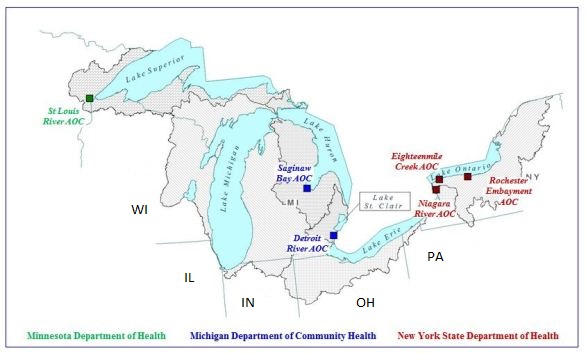Risk Assessment
Related Topics
Environmental Health Division
Biomonitoring Study of a Tribal Community Living in the Lake Superior Basin
Minnesota Department of Health is collaborating with the Fond du Lac Band of Lake Superior Chippewa on a public health biomonitoring study. The study includes people who are affiliated with any tribal nation and live in northeast Minnesota. The study is funded by the Great Lakes Restoration Initiative, the U.S. Environmental Protection Agency and the federal Agency for Toxic Substances and Disease Registry. ATSDR chose to fund public health agencies in Minnesota, Michigan, and New York to conduct human biomonitoring studies of population groups who may be more exposed to environmental chemicals in Great Lakes watersheds. In Minnesota, the biomonitoring study began enrolling participants in December 2012.
Funded Agencies and Areas of Concern
What is biomonitoring?
Biomonitoring is the measurement of chemicals in a person, by sampling and analyzing their tissue and fluids. Biomonitoring techniques are used to measure a person’s body burden, which is the amount of environmental chemicals stored in the body at a given time.
What is the purpose of this study?
In Minnesota, the biomonitoring study is of a tribal community living in the Lake Superior Basin. Over the past century, industrial operations and activities of modern life have released chemicals into the air, water, and soil. When these chemicals are present, especially in local lakes, rivers, and wildlife, they may harm the environment and the health of people who use these resources. People living in this community may have greater contact with environmental chemicals as consumers of traditional foods such as fish and waterfowl. The purpose of this study is to:
- measure the amount of certain environmental chemicals in a tribal community living in the Lake Superior Basin;
- determine how the levels of chemicals measured in this community differ from those in the general U.S. population;
- learn how the foods and activities of participants may be related to chemicals in their bodies; and
- develop data-driven public health actions that enable the tribal community members to make informed choices about protecting their health.
Who can be in the study?
To be eligible, one must be:
- Native American
- 18 years or older
- Not pregnant
- A resident of northeast Minnesota for the past 12 months; and
- Medically able and willing to give a blood and urine sample for testing of environmental chemicals.
People participating in the study will travel to Min No Aya Win Human Services in Cloquet for one appointment. After reviewing and signing the informed consent form, participants will be asked to provide a blood and urine sample and answer interview questions. The clinic visit will take about 1 1/2 to 2 hours.
What chemicals will be measured?
The chemicals that will be measured (PDF) include persistent, bioaccumulative “legacy chemicals” as well as “contaminants of emerging concern” such as those found in personal care products and plasticizers. The following environmental chemicals will be measured: cadmium, mercury, selenium, lead, polychlorinated biphenyls (PCBs), mirex, hexachlorobenzene, DDT/DDE, toxaphene, 1-hydroxypyrene, perfluorinated compounds (PFCs), bisphenol A, triclosan, and cotinine. In addition, omega-3 fatty acids will be measured to provide information on the health benefits of eating fish.
As a benefit to the participants, hemoglobin A1C, blood pressure, and total cholesterol will also be measured to inform participants about their risk for diabetes and cardiovascular disease.
Blood and urine will only be tested for the chemicals listed above. Any left-over blood and urine will be destroyed at the end of the study.
How will results be shared?
Participants will get their results by mail. Results related to diabetes and heart health will be sent within a few weeks after the clinic visit. If tests show high amounts of mercury, lead, or cadmium, participants will get these results quickly, too. The rest of the results will be sent when all the participants’ samples have been tested. A summary of results will be shared publicly after the study ends. Individual participants will not be identified in any reports, documents, or other released information.
How is this study different than past studies?
- This study will directly measure the amount of chemicals in people; as opposed to the monitoring of chemicals in the environment or in food.
- Participants will learn how these chemicals may be related to food they eat and their everyday activities.
- Findings will identify vulnerable groups who may have higher levels of exposure.
- This study will add to information from national biomonitoring efforts of the general population because those studies don't represent certain subpopulations that may be more highly exposed to environmental chemicals.
- Input from the tribal community is being used to ensure that it is designed and carried out in ways that are acceptable and that study findings are interpreted and disseminated in culturally relevant and useful ways.
- In addition to biomonitoring measurements, the questionnaire results will provide useful information about exposure sources and routes within the community.
Will the study results be used to improve public health?
Study findings will be used by the Minnesota Department of Health and the tribal community to develop a data-driven public health action plan to prevent or reduce exposures to Great Lakes chemicals through targeted outreach and interventions.
Biomonitoring results for the majority of the chemicals being measured in participants cannot provide definitive answers about individual health risks.
For more information, contact biomonitoring study staff at 218-878-2193.
